Jan 06 2010
Good Aged White Wine

Stop scratching your head. Stop wrinkling your nose. Good aged white wine? Could it be possible?
Visit countless wineries and you will hear the same advice repeatedly: “Drink your white wines young, maybe one or two years post release.” And generally, this advice is true. However, there are some white wines which can be aged (such as Chardonnay) and depending on the grapes incorporated into a white wine, some blended white wines can age as well, too.
If this is still too much to process or too great a risk to take on your own, do not fear. Thanks to the generosity of a friend, I have two older vintages of a delicious white blend wine with which to experiment.
Having confidence to try an aged white wine (let alone have the courage to age one) can definitely create a dilemma. Given the present undertaking, it is appropriate that the wine selected is called “Conundrum”. Conundrum is a great California blended white table wine. While the actual composition of the wine is kept a secret, it is commonly known to consistently contain Chardonnay, Sauvignon Blanc, Muscat Canelli and Viognier. Each one of these white grapes will lend different aromas, acidities, flavor profiles and mouth feels to the ultimately blended wine. Viognier is best known for its tremendous capacity to provide highly aromatic and floral bouquets. Sauvignon Blanc can lend crisp acidity and often times green apple or lemon flavors. Chardonnay is the classic butterball, adding aromas of vanilla and a creamy mouth feel. Muscat Canelli is typically used for dessert wines so while it is certainly added for sweetness, it can also be known to add a bit of fizz or slight carbonation (as traditionally made in Italy). Finding a bottle of the recent vintage of Conundrum at a local restaurant or wine shop will not disappoint the palate and does not require any aging. However, what happens if a bottle is set aside for a few years?
As noted, a friend kindly presented me with two older vintages of Conundrum wishing that I would taste them, compare them and share my thoughts. Given that I just finished discussing the aging of red wine, it was timely to explore aged white wine. The two wines that are up for tasting are (each) bottles of the 2002 Conundrum and the 2003 Conundrum.
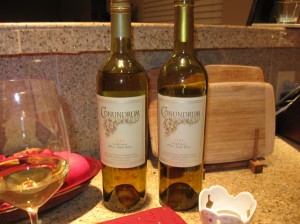
Interestingly enough, at first observation, the 2002 vintage uses a cork and the 2003 vintage uses a screw-cap. A screw-cap? Before you are distracted by memories of your dad storing cheap wine in the garage, there are benefits to using a screw-cap as a closure with wine. The screw-cap does create an air tight seal, which is important to preserving aromas and flavors found in a wine. While a cork also creates an air tight seal (as it expands to close off the wine from oxygen after bottling), if the wine is not properly stored on its side to keep its cork moist and fully expanded, it will eventually dry out possibly leak and even run the risk of creating a phenomenon called “corked wine”. If a cork is faulty, it will create a chemical compound called 2, 4, 6-Trichloroanisole (TCA) which will lend a musty and moldy characteristic, ultimately ruining the wine. As a result, the screw-cap can be a smart alternative.
Opening first the 2002 Conundrum, at first inspection, the cork is still intact and still moist. Pouring a bit of the wine into the glass, there is no musty or moldy smell and at first sip, the wine is still easily drinkable. Next, opening the 2003 Conundrum (which sports that controversial screw-cap), the wine has a more pronounced bouquet and equally tastes fine, but with a bit more acidity. Upon initial comparison, both wines have aged well and it is quite possible that the screw-cap has made a difference in preserving the wine’s attributes given the floral bouquet is more pronounced and the acidity lends itself to almost a tiny bit of fizz which a more recent vintage would show off more. However, given that the winemaker does not reveal the exact composition of the grapes each year, there is no way to verify if some of the differences initially noted are due to the different closures or due to differences in percentages and the types of grapes used.
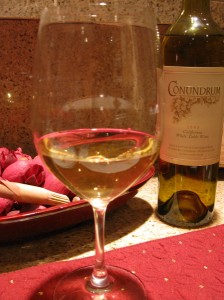
Revisiting the two vintages (now confident that both have aged well and that one was not corked), the differences in the aroma, palate and mouth feel are quite distinct:
2002 Conundrum: Slightly darker in coloring, the wine is beautifully (yet subtly) aromatic despite having aged now eight years, presenting notes of melon, butterscotch, and french vanilla which easily reminds one of crème brulee. The wine impresses the palate with a smooth creamy consistency with flavors of crème brulee and a hint of tropical fruit. The traditional fizz noted in young vintages of Conundrum is not present in the 2002 vintage but strangely, it is not missed. The body of the wine is still noticeable, thereby not rendering it flabby. Of particular enjoyment, the wine’s acidity is in perfect balance making it an exceedingly pleasant, easy drinking aged white wine.
2003 Conundrum: It is with fascination that one wonders if the more markedly predominant bouquet is due to the screw-cap closure. The nose on the wine is indeed stronger, representing notes of butterscotch, custard, a hint of apricot and florally tantalizing with lemon blossom. Again, due to aging, the fizz that the Muscat Canelli might produce is not present, but instead the 2003 vintage does show off some acidity making the wine a bit brighter and more upbeat in personality. The mouth of the wine is not overwhelmingly smooth and creamy as the 2002 vintage, but this is a wine that will still easily serve well once temperatures warm and serve alongside seafood or appetizers such as melon wrapped with prosciutto.
As tasting continues and given the grapes used to create Conundrum, it becomes more and more apparent that this wine is the perfect candidate for creative food pairings. While the wine could technically be paired with a variety of meals and dishes and transcend from casual to formal settings with ease, I have elected to create something simple which is layered in flavors and easily shared with others in the spirit of casual entertaining:
· Faux Apricot Honey Fondue
Fondue is a fun way to entertain, but if you are looking to avoid the clutter and clean up of a fondue pot, it is easy to achieve both by creating what I call a “Faux Fondue”. In doing so, I have first taken a portion of a sourdough baguette, slicing along throughout it and brushing it with melted butter so that it will crisp a bit in the oven. Once slightly toasted, I thinly layered brie cheese across the top, followed by pure apricot fruit spread and drizzled across with tupelo honey. As if that is not enough to make one drool, next it is tucked into the oven just long enough for the brie cheese to melt and the flavors to meld.
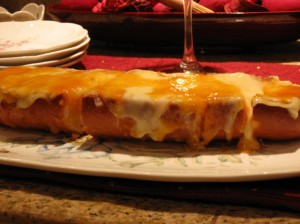
Out of the oven and allowed to cool for a few minutes, next a thin sharp knife is used to gently separate the pre-cut slices and easily serve to guests alongside the two wines that are being tasted and compared. The result is a heavenly “oohey-goohey” fondue sensation with rich and creamy brie, a sweet semi-tart apricot and an indescribably seductive honey.
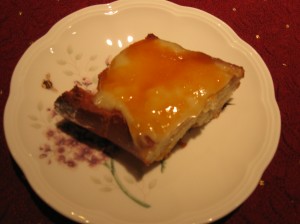
And which vintage did the Faux Fondue best pair with? The 2002 vintage of Conundrum won this test as its own smooth and creamy mouth feel matched the same sensation in the food. Additionally the buttery and salty taste of the brie, the tartness of the apricot and the hint of honey naturally paid tribute to the mysterious entourage of white wine grapes typically found in Conundrum.
The next time you are rushing yourself to finish your white wines in your collection, consider setting one or two aside to age for a few years. It may be a task in vain or it may delight your senses. In the end, it is not a very difficult conundrum to solve.
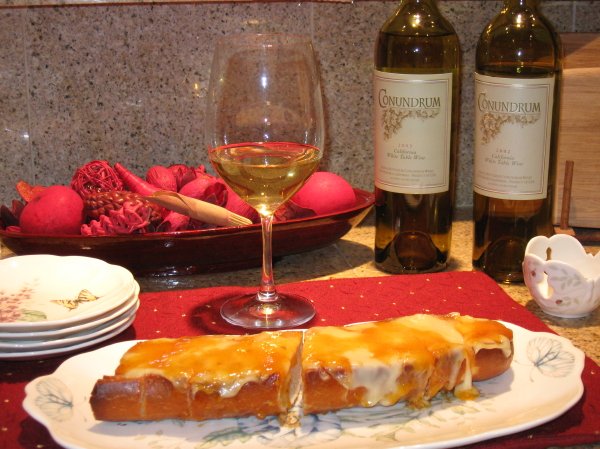
Comments Off on Good Aged White Wine